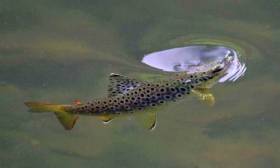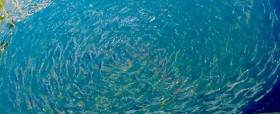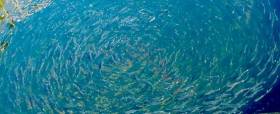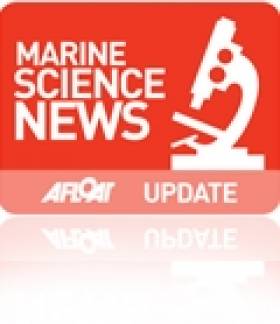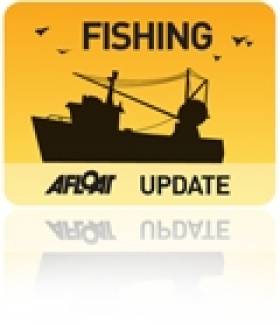Displaying items by tag: fish farming
Inland Fisheries Ireland (IFI) says it is progressing its plans to develop a new modern fish farm facility in Co Tipperary based on ‘recirculating aquaculture system’ (RAS) technology.
The new aquaculture project will be located in Roscrea and it will shortly enter the design and planning permission phase.
It is expected that the new fish farm will become operational in 2026, says the the statutory body responsible for inland fisheries in Ireland.
In the meantime, IFI says it expects to continue its current fish farm operations as normal, supplying brown trout and rainbow trout to its angling stakeholders.
IFI has has placed a Prior Information Notice (PIN) on the Official Journal of the European Union (OJEU).
Any businesses or individuals that are interested in this public procurement process can register for email alerts on the eTenders website.
RTÉ’s Prime Time Looks at Plight of Ireland’s Wild Salmon
On a special climate-focused edition of RTÉ’s Prime Time this past week, the news programme put the plight of Ireland’s wild salmon stocks in the spotlight.
Reporter Oonagh Smyth visited the Dawros River in Connemara where salmon runs have allegedly shrunk from as many as 3,000 two decades ago to less than 900 today.
These figures lead to an even worse picture nation-wide, with data showing that only 150,000 wild salmon returned to their spawning grounds in 2019 — a decline of almost 80% on the more than 685,000 salmon recorded in 2000.
Various reasons are behind this alarming fall, with climate change chief among them — forcing salmon to migrate further to find colder waters, and interrupting the food webs that sustain the fish at sea and in our rivers.
But local factors have also been blamed, including the licensing of open-cage salmon aquaculture against which conservation groups and some arms of the State are united in their opposition due to the risks of sea lice infestations.
RTÉ News has much more on the story HERE.
New Protections For Wild Brown Trout As Designated Salmonid Waters Bye-law Comes Into Operation
#Angling - The Designated Salmonid Waters Bye-law was yesterday (Thursday 25 October) signed by the Minister for Communications, Climate Action and Environment, Richard Bruton.
The overall intention behind the bye-law is to afford additional protection to wild brown trout in seven distinctive State–owned waters where established stock control measures are already in place as a matter of existing policy.
The seven waters are Lough Sheelin in the Limerick Fishery District; Loughs Conn and Cullin the Ballina Fishery District; Loughs Corrib, Mask and Carra in the Galway Fishery District; and Lough Arrow in the Sligo Fishery District.
Sean Canney, who is succeeding Sean Kyne as Minister of State with responsibility for the inland fisheries sector, welcomed the bye-law as an important initiative for brown trout fisheries particularly in the West of Ireland.
“My predecessor Seán Kyne gave notice of his proposals to make the bye-law and also instigated a public consultation during which observations and views expressed across the full range of stakeholders,” said Minister Canney.
“I am happy as incoming minister to support Minister Kyne’s long-standing initiative and his hard work over all of 2018 in bringing the bye-law to fruition.”
Minister Kyne said: “As minister with responsibility for inland fisheries, I had carefully considered the submissions made in the public consultation.
“The bye-law relates to seven limestone lakes which are quite unique in terms of topography and trout habitat and have long been managed as wild brown trout fisheries via established stock management programmes. From that perspective, I considered that these waters are especially important.
“The bye-law was just about complete when I was taking on my new role and I am grateful for the support of Ministers Bruton and Canney for bringing it over the line,” he added.
The bye-law gives statutory status to the policy designation of this small number of distinctive waters and means that the waters concerned will continue to be managed primarily as brown trout waters.
Minister Kyne had indicated his view that the importance of these waters should be reflected by way of statutory designation and commenced that process in the department.
The bye-law also includes the prohibition on the introduction of fish to the designated waters which is consistent with the overall policy thrust of Inland Fisheries Ireland to manage these waters primarily as brown trout waters.
The advantages of this measure include addressing biosecurity and genetic concerns, control and management of the potential transfer of pathogens, and safeguarding against the introduction of alien invasive fish species.
The announcement came as Bord Iascaigh Mhara is hosting a two-day conference on the scientific developments within the salmon farming industry in Galway’s Maldron Hotel on 25-26 of October.
Outlining the purpose of the event, BIM’s Geoffrey Robinson said: “With increasing global demand for fish, aquaculture is now the fastest-growing animal food production sector in the world. Consequently, fish farming operations are rapidly evolving with new technologies and equipment constantly being developed.
“Part of BIM’s work is to help fish farmers to keep their operations at the cutting edge of technology and an event like this allows us to showcase the latest innovations to Irish operators. There will be a number of interesting developments discussed not least the growing use of cleaner fish and desalination systems.”
Twenty-five separate presentations from national and international experts will cover the latest research and technological developments within the sector on issues such as fish health and welfare, structural and service equipment as well as organic certification.
“While production volumes in Ireland are small by international standards, we have a reputation for excellence in organic salmon production and it is important that our operations maintain this high standard. Incorporating leading edge technologies can improve our production efficiencies and strengthen our sustainable practices,” Mr Robinson added.
In 2017 Irish salmon production increased 15.6% to 19,305 tonnes, with a value of €141.2 million. The industry employs 210 people, primarily in production sites along the west coast of Ireland. Irish salmon is exported to diverse markets across the EU, North America and the Near and Far East.
Report Confirms Presence Of Farmed Atlantic Salmon In Galway & Mayo Rivers
#Angling - As many as 500 farmed salmon could have entered a number of rivers in Galway and Mayo last autumn, according to a new report from Inland Fisheries Ireland (IFI).
The report into the incident in the Western River Basin District also confirms that no reports of escapes in the relevant period were made by local salmon farm owners, as previously reported on Afloat.ie.
The reporting of escapes to the Department of Agriculture, Food and the Marine (DAFM) are a condition of aquaculture licences.
IFI’s reports says that “up to 500 escaped farmed salmon may have entered western salmon rivers during the August/September period 2017.”
And it adds “that the presence of sexually mature farmed salmon in rivers poses a potential threat to local wild salmon populations from interbreeding and other ecological effects.”
In October 2017, the board of Inland Fisheries Ireland issued a statement noting that it :continues to have concerns regarding the impacts of fish farms on Ireland’s precious wild fish.
“The licencing regime and best management practice should provide assurance to the State that controls are in place that safeguard our heritage. This does not appear to be the case in this instance.
“Inland Fisheries Ireland supports sustainable fish farming but cautions against the renewal and/or award of licences where conditions are not being adhered to. The board recommends immediate strict enforcement and audit of existing licence conditions to ensure compliance and ultimately a sustainable resource for all.”
Speaking on the publication of the new report, IFI head of R&D Dr Cathal Gallagher said: “While a small number of farmed salmon spawning in a catchment may not have a detectable long-term effect on the wild salmon population, repeated escapes of large numbers of farmed fish have the potential to cause serious damage to vulnerable wild salmon populations.
“The large number of escaped farmed salmon entering into these rivers, with a high proportion of males likely to be sexually mature, presents a potential threat to local wild salmon populations.
“IFI will continue to monitor the situation and may need to conduct longer-term genetic studies on the impact of the presence of these farmed salmon.”
The full report is available to download below.
#Salmon - Inland Fisheries Ireland (IFI) confirms that 65 farmed salmon have been caught in five rivers in Counties Galway and Mayo.
The news follows concerns raised by wild salmon conservationists since a major fish kill by jellyfish stings that has wiped out stocks along the West Coast in recent weeks, as previously reported on Afloat.ie.
But fears regarding salmon farm management and oversight have also grown as at yesterday (Monday 9 October), IFI understood that no escapes of farm salmon had been reported to the Department of Agriculture, Food and the Marine by salmon farm owners.
“The licencing regime and best management practice should provide assurance to the State that controls are in place that safeguard our heritage, this does not appear to be the case in this instance,” said the IFI board in a statement.
As of yesterday, 65 farmed salmon escapees have turned up on the Delphi, Erriff, Kylemore/Dawros, Newport and Bunowen rivers.
The scale of the escape is not fully understood at this time as the majority of fish were caught by anglers, who generally only encounter a small proportion of salmon in a river.
IFI says its scientists are analysing captured fish in an attempt to identify the history and maturity status of the farmed salmon, and create a fuller picture of the risks to wild salmon stocks.
Of the farmed fish examined by yesterday, three males were mature on capture and had the potential to spawn in the wild.
IFI adds that the various catchments are already under pressure due to significant decreases in salmon runs over the last twenty years.
All fish entering the Erriff are monitored in an upstream trap allowing for the removal of farmed fish. But there are no such trapping facilities available on the other systems.
IFI says its staff will continue to monitor the situation despite the difficulty in assessing exact numbers without details from the affected fish farms.
Jellyfish To Blame For Major Salmon Farm Fish Kill
#Jellyfish - Four-fifths of the farmed salmon stock at Killary Harbour has been lost to fatal jellyfish stings over the last few weeks, according to The Irish Times.
The Marine Institute has confirmed that naturally occurring swarms of the tiny Muggiaea atlantica and the larger mauve stinger are responsible for the deaths of tens of thousands of fish across four fish farms from Connemara to Bantry Bay.
It marks the worst recorded salmon farm fish kill since 250,000 salmon were lost in Northern Ireland in 2008.
Farmed salmon in Connemara alone was worth €38 million in 2016, as the Connacht Tribune reports.
Meanwhile, wild salmon conservationists have also raised concerns over the potential impact of farmed fish that have reportedly escaped into Ireland’s salmon rivers as a result.
The Irish Times has more on the story HERE.
Salmon Farms 'Can Have Significant Impact' On Wild Salmon and Sea Trout Stocks – IFI
#SeaLice - The chairman and board of Inland Fisheries Ireland (IFI) have welcomed a definitive review of over 300 scientific publications on the effects sea lice can have on sea trout stocks.
A team of top international scientists from Norway, Scotland and Ireland reviewed all available published studies on the effects of sea lice and have now concluded that sea lice have negatively impacted wild sea trout stocks in salmon farming areas in Ireland, Scotland and Norway.
Previously research was based on individually published studies, but this new review reached its conclusions based on comprehensive studies of the effects of salmon lice from over 300 scientific publications.
The project was funded by the Norwegian Seafood Research Fund, which provides investment in Norwegian seafood industry-based R&D with the objective of creating added value for the seafood industry.
The study also examined the potential effect of sea lice on salmon and concluded that sea lice have a potential significant and detrimental effect on marine survival of Atlantic salmon with potentially 12-44% fewer salmon spawning in salmon farming areas.
“These conclusions concur with previously published Inland Fisheries Ireland research on the potential impact of sea lice from marine salmon farms on salmon survival,” said IFI chairman Brendan O’Mahony.
The studies reviewed indicate that salmon farming increases the abundance of lice in marine habitats and that sea lice in intensively farmed areas have negatively impacted wild sea trout populations. The effects of sea lice on sea trout are increased marine mortality and reduced marine growth.
IFI says this new study confirms the evidence collected since the early 1990s in Ireland regarding the impact of sea lice on wild sea trout stocks, particularly in relation to the collapse of Connemara’s sea trout stocks.
The board of IFI reaffirmed that it has consistently called for marine salmon farms to maintain sea lice levels close to zero prior to and during the wild sea trout and salmon smolt migration period in spring.
IFI has also raised concerns regarding the location of salmon farms in the estuaries of salmon and sea trout rivers.
The IFI board says it believes this new review confirms the need for very tight regulation of sea lice levels on salmon farms and raises legitimate concerns with regard to the potential impact of new, large scale salmon farms, proposed along Ireland’s west coast, on salmon and sea trout stocks.
It's expected that regulators will now consider the results of this new review when making decisions on the sustainability and approval of future marine salmon aquaculture licences and the regulation of sea lice at existing sites, so as to ensure no negative impact on salmon and sea trout stocks.
Sea Lice Pose Significant Threat to Wild Salmon Says New Research
#ATLANTIC SALMON - About 39% of salmon mortalities were attributable to the impact of sea lice on wild salmon fisheries, according to a new international study.
The research, published in Proceedings of the Royal Society B, involved experts from Inland Fisheries Ireland collaborating with the Scottish Oceans Institute at the University of St Andrews, the Department of Zoology at the University of Otago in New Zealand, the Atlantic Veterinary College at the University of Prince Edward Island in Canada and the Institute of Marine Research in Norway.
In a statement on the report, IFI says: "In previously published studies, groups of salmon smolts were treated to protect them against sea lice infestation and other groups were untreated and both groups released to sea into 10 areas of Ireland and Norway. A proportion of these released fish were recaptured as adult salmon one or more years later.
"Analysis of the results of all previously published studies together provide experimental evidence from a large marine ecosystem that sea lice can have large impacts on salmon recruitment, fisheries, and conservation. The sea lice were likely acquired during early marine migration in areas with salmon farming, which elevate local abundances of sea lice."
IFI says the results "indicate that parasite-associated mortality may cause the closure of some fisheries when conservation targets of return adult abundances are not being met. However, the implications of these results may be most serious for small populations in small river systems."
The inland fisheries body explains that the high natural mortality rate of both treated and untreated salmon groups was accounted for, which revealed "a large effect of parasites".
"Precisely because natural mortality rates are high, even a proportionally small additive mortality from parasites can amount to a large loss in adult salmon recruitment," it adds.
Minister of State for Natural Resources Fergus O'Dowd welcomed the report, stating: “From the results of this detailed study, it is crucial that sea lice levels are maintained below [designated] protocol levels, particularly in spring when wild salmon smolts are migrating to sea to avoid increased marine mortality.
Minister O'Dowd added that the results of this study "augment our knowledge in the context of proposals for aquaculture development".
The news comes in the wake of IFI's dispute with Bord Iascaigh Mhara over the exclusion of a report critical of the proposed new deep sea wild salmon farm in Galway Bay from the statutory consultation.
The scheme has faced opposition from local salmon anglers who fear the new facility would pose a threat to wild salmon stocks in Irish rivers by increasing the risk of sea lice infection.
NI Anglers Opposed to Exclusive Protected Status for Farmed Salmon
#ANGLING - Northern Ireland anglers have balked at proposals to secure protected region of origin status for 'Irish salmon' so that only farmed salmon can use the name.
As the Belfast Telegraph reports, the Ulster Angling Federation (UAF) has lodged an objection to the application for protected geographical indication (PGI) status, of the kind that protects the names of foods and drinks like Champagne and Parmesan cheese.
NI anglers argue that the term 'Irish salmon' has been seized by the aquaculture industry "to create the illusion that consumers are receiving a wild Irish product".
UAF chair Jim Haughey suggests that the name be amended to 'Farmed Salmon from Ireland'.
BIM Decries 'Scare Tactics', Urges Support for Fish Farming
#FISHING - Bord Iascaigh Mhara (BIM) has called on environmental campaigners opposed to changes in the current fish farm licensing system to "get behind Ireland's aquaculture industry".
In a letter to The Irish Times yesterday, the fisheries board wrote in response to Tony Lowes of Friends of the Irish Environment, whose own letter to the paper on Tuesday lambasted the IFA's claims of an "inexplicable delay" in the State's processing of licence applications for new fish farms off the west coast.
BIM chief executive Jason Whooley said it was "refreshing" to read Lowes "expressing confidence in and support for the current Irish aquaculture licensing system", which is "both rigorous and science-based... involves a high level of public consultation and is fully transparent."
However, Whooley hit out at what he described as Lowes' "scare tactics" and "spurious" attempts "to mislead by comparing the output from a salmon farm with human sewage".
Lowes had written that salmon farming "is a highly polluting industry", and that discharge of nitrogen and phosphorous from aquaculture facilities "can fuel toxic algae blooms, which have cost the shellfish industry dear".
Whooley countered that argument, stating that "the harmful elements from human sewage, such as E.coli, cryptosporidium or viruses, are simply not present in the excretions from cold-blooded creatures, such as the Atlantic salmon."
He also urged Lowes to "get behind Ireland’s aquaculture industry and support it as a sustainable and valuable source", adding that "increasing the output of farmed Irish organic-certified salmon represents a great opportunity to create a large number of sustainable jobs in Ireland’s coastal communities."



























